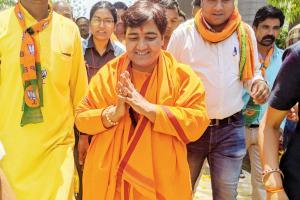The old city which is punctuated with old Islamic and Hindu structures bears a festive look ahead of the beginning of the holy month of Ramzan

Sadhvi Pragya Singh Thakur at a rally in Bhopal. Pic/Dharmendra Jore
People here talk endlessly of Ganga-Jamuni tehzeeb (the fusion of Hindu and Muslim cultures) when we coax them into commenting on the local Lok Sabha fight that has become a national attraction, because of the candidature of BJP's Sadhvi Pragya Singh Thakur, who may have set a record of receiving notices from the election authorities on the charges of breaching the model code of conduct through her controversial statements.
ADVERTISEMENT
People of Bhopal - both Hindus and Muslims - have the same question. Why did BJP, which has been winning elections here for 30 years, field Sadhvi when it had good leaders in its rank? Seated at a tea shop, Mohammed Syed and his buddy Ram Narayan do not differ in their opinion when they abhor any attempt of creating a communal tension in the capital of Madhya Pradesh which has a considerable Muslim population. The successive poll results indicate that the principal communities are split in their political views, but they have desisted from turning it into danga-fasaad (riots).
The old city which is punctuated with old Islamic and Hindu structures bears a festive look ahead of the beginning of the holy month of Ramzan. "You must visit the eateries here to find how many Hindus enjoy the Ramzan food," Narayan says. "I'm told Mumbai's Bhendi Bazar too is frequented by Hindus."
Javed Ali, a taxi driver who undertakes tours of the city, makes a profound statement. "No tragedy distinguishes between the Hindus and Muslims. Both communities lost their dear ones in the gas leak tragedy and bore the brunt of communal riots years ago."
As we pass on through the old city, we spot a temple that bears an unusual name – Curfew Wali Maa Bhavani. Apparently, when a permanent temple was being built at Somwara Square in 1982, Muslims had opposed the construction. Subsequent communal tension forced the administration to impose a curfew for days together. Since then the deity is known as Curfew Wali Maa. Little wonder then that Sadhvi Pragya visited the temple before filing her nomination and returned again to take part in the kirtan even when she was banned from campaigning.
Sadhvi told media persons that the bhajan and kirtan was a way of her sanyasi life, and whoever stopped her from worshipping should first think about their own life. On campaign, she keeps away from media. When asked for an interview, she says "baadme" (later). But she makes herself amply clear through her brief speeches. She emerges at the roof of a plush vanity van (we're told ex-CM Shivraj Chauhan has lent her his customised campaign vehicle). "This is the fight for dharma and tapasya. I have suffered a lot from the people who are opposing me. Defeat them for the country, god and religion," she says, before leading a large convoy of vehicles of the police, supporters and media. Her road show in the BJP's bastion of Kolar on Sunday evening measures a couple of kilometres. The polarization is quite eminent.
Challenge for Congress
Congress candidate Digvijay Singh tries to match Sadhvi in every move, expect for longer convoys and vanity. He calls Sadhvi selective and divisive. "I talk development, do they?" he questions. Sadhvi's campaign reaches Buddhist scholars for support next day.
Political commentator T Ashish sees a remarkable change in Digvijay Singh's approach to the elections. "BJP has changed the city in the past 15 years like anything. What is striking is that the BJP has forced the Congress to talk development which wasn't as much in the time of Digvijay who was happy experimenting social engineering in the state. With its core vote-bank intact, the challenge for the Congress is to manage a significant swing in its favour," he said.
Catch up on all the latest Crime, National, International and Hatke news here. Also download the new mid-day Android and iOS apps to get latest updates
 Subscribe today by clicking the link and stay updated with the latest news!" Click here!
Subscribe today by clicking the link and stay updated with the latest news!" Click here!






